To view this content, you must be a member of the Rose City Review Patreon
Already a qualifying Patreon member? Refresh to access this content.
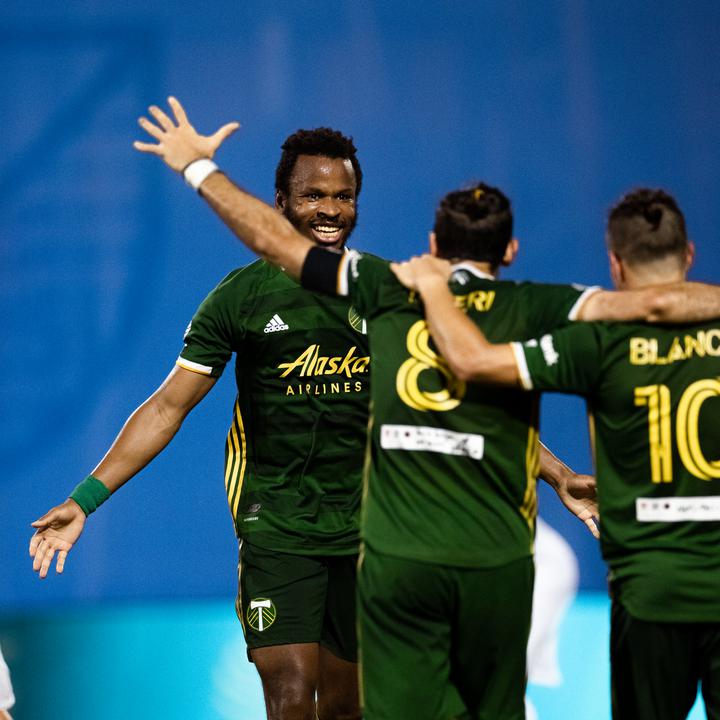
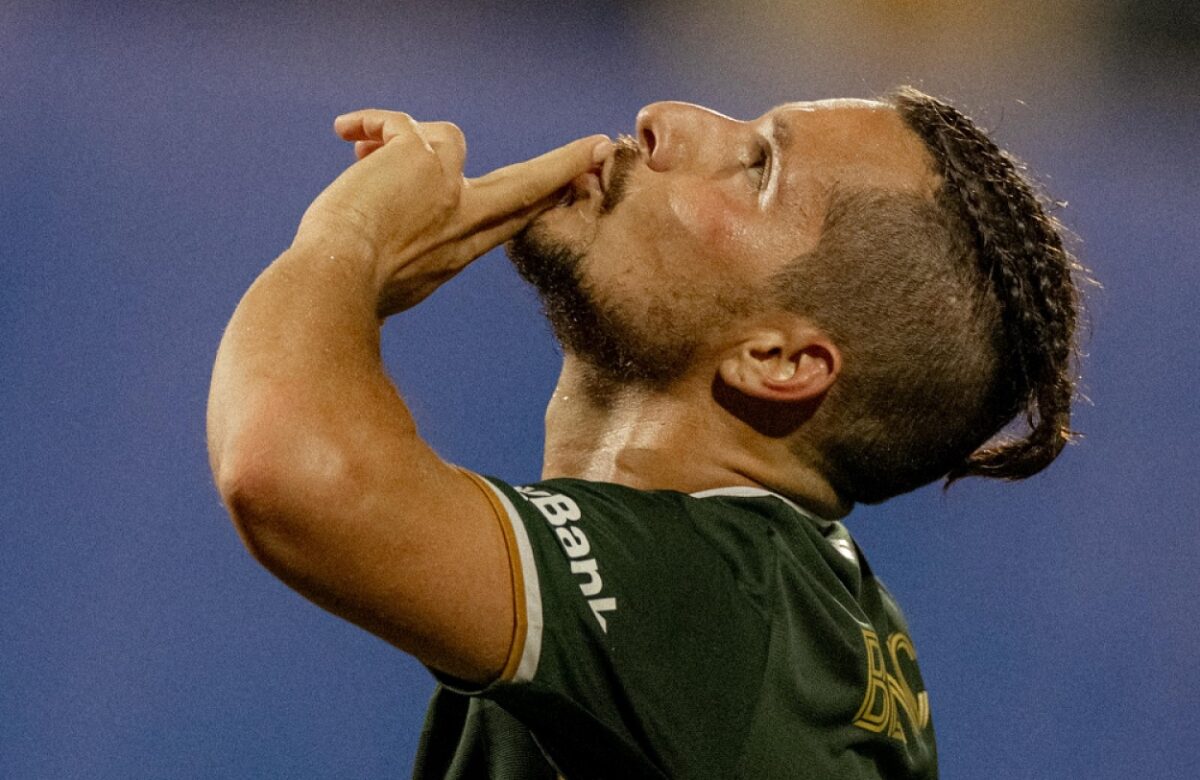
After four months without a match, the Portland Timbers returned to play last night in the MLS is Back Tournament. Before the opening whistle, cameras at the ESPN Wide World of Sports caught Diego Valeri in a smiling conversation with an LA Galaxy player.
Moments later, the Maestro and every other player on the pitch were kneeling in silence.
And moments after that, the whistle blew and the Timbers were once again playing soccer.
Despite a 75th minute red card to center back Dario Župarić, the Timbers were able to snatch all three points in Monday night’s up and down affair against the Galaxy––taking down the Californian side 2-1 in their first action since the suspension of the MLS season back in March. The match itself played out in four phases:
It was that third phase that gave us the most exciting moments to hold on to when the Timbers opened the scoring in the 59th minute and quickly followed that up with a second goal in the 66th.
The first goal was a pure distillation of this Timbers side. Yimmi Chará started the moment with an impressive snap header on goal off a cross that looked over-hit, forcing David Bingham to palm the ball away with a quick reaction save. Then Diego Valeri and Sebastián Blanco combined brilliantly as the Maestro received the ball at the top of the Galaxy box and patiently picked out a long, curving run from Blanco in behind the Galaxy back line. And, finally, Blanco was able to turn on the ball and pick out Jeremy Ebobisse in front of goal, threading a pass through a handful of defenders for Ebobisse to knock home despite a defender firmly attached to his back.
The second goal was simply down to the sheer cussedness of Blanco. After a shot from Ebobisse was deflected off his foot and sent looping away from goal, it seemed certain that the Timbers attack was broken and the Galaxy would have a chance to clear. As the ball fell back to earth out on the wing, however, Blanco refused to let it die. Rushing forward, he got a head to the ball, catching a defender unaware and skillfully touching it toward goal where another Galaxy defender was waiting to make the tackle. Instead, Blanco was able to somehow push the ball through that second defender and into space in front of the Galaxy goal where he wrapped up the move by hamming home a shot from close range that left Bingham waving hopelessly at the ball as it flew by.
While Blanco and the Timbers attack grabbed the win for the side, the defense nearly gave the game away on two occasions before clamping down and securing the three points for the side.
In the 11th minute, on one of the first attacking moves from the Galaxy as they tried to escape a protracted period of possession from the Timbers, a deflected ball fell to Cristian Pavón twenty yards from goal. Approaching the top of the box, the Galaxy No. 10 let loose a shot that flew directly into the torso of Župarić, clattering off his arms and immediately drawing a whistle and a yellow card from referee Ramy Touchan.
Chicharito Hernández stepped up to the spot and, with Timbers hearts sinking, struck his attempt on goal. Steve Clark, however, had other ideas and, reading the Mexican international legend’s run up, dove the correct direction and stopped his shot. Then, scrambling, Clark did the splits to stop the follow-up from Sacha Kljestan before diving on the ball to end the Galaxy hopes of an easy opener.
Although he was bailed out by Clark, that yellow card would come back to haunt Župarić in the 75th minute when he took down Pavón just outside the Timbers box, prompting an easy second yellow from Touchan and leaving the Timbers down a man for the rest of the game.
While the Galaxy would eventually find the back of the net in the 88th minute when Chicharito momentarily showed off some of the predatory instincts that made him such an effective player throughout his career, they were stymied time after time by the Timbers backline stepping up for an offside trap or swarming the ball to take advantage of a loose touch, or simply knocking away cross after cross that the Galaxy sent hopefully into the box.

The final game of the Thorns Extended NWSL Challenge Cup Preseason ended in a scoreless draw. A late Chicago winner last night means that the Thorns will be squaring directly up with the North Carolina Courage in the quarterfinals.
The Thorns haven’t had the most productive tournament in terms of goals, but if we look at these games as a challenge for a rebuilding squad to test themselves against, they’re getting what they came here for. They’ve faced off against the toughest teams in the tournament and are about to go against the best once again.
OL Reign have been a real mystery so far this tournament. They have a different style of play than anyone in the league has ever had. It hasn’t been great to look at, and the Reign didn’t have a single shot through 30 minutes of this game. But the Reign did not need a win today, and Portland did. New Reign coach Farid Benstiti has made it a point for his team to not lose in this tournament, and his team played a specific game to prevent that above all.
The Thorns started with Simone Charley and Morgan Weaver up top, and with Portland very comfortably parked directly in front of the Reign box in the first half, it seemed like kind of a waste.
You see, Simone Charley Ran Track. She’s fast. She’s also a sprinter who usually does not last 90 minutes because of how much she puts into every forward run. Charley was putting up a real fight pressing the Reign backline in the first half. But with the Reign sitting very deep, it felt like a waste. Charley’s best moments are in the open field where she can put defenders on skates, create separation from her defenders, and create. Up against a set defense, however, she and the rest of the team struggled to do more than cross the ball somewhat aimlessly.
As the game opened up in the second half, Charley came off for Tyler Lussi in what was pretty clearly a planned substitution at the 60 minute mark. Unfortunately, the first few actions of the second half were Charley’s best of the game, with her crossing into the center where no one was waiting, only to put the second service over the bar.
There’s obviously no telling how games will go ahead of time. But most people could probably have told you that the game was going to open up the more that it went on. It was a shame not to have her speed on the break as both teams got more frantic. The rotation in the first game against North Carolina, with Lussi and Marissa Everett eating up minutes and pressing the backline only for Weaver and Charley to come on later, may be one we see against the Courage a second time on Friday.
Emily Menges was not available for selection today after showing up as questionable on the injury report. With Becky Sauerbrunn out for the tournament, Meghan Klingenberg was the only locked-in first choice Thorns player in defense going up against a Reign team that looked, on paper, very strong. Bethany Balcer had to depart early, but Jodie Taylor and Sofia Huerta are both highly experienced NWSL attackers. Yes, the Reign played conservatively, but all three forwards are more than capable of making things happen on their own.
And basically nothing happened. The Reign couldn’t put a single shot in for the first 35 minutes, and when they grew into the game in the second half, a defensive setup that could have been shaky ended up looking solid.
Kelli Hubly has now started three games for the Thorns in central defense. One or two mishaps aside, Hubly looked solid, putting in some strong tackles on Reign forward Yuka Momiki to keep the most dangerous Reign player pretty contained. Christen Westphal looks totally comfortable at right back for this team, providing important offense down the flank.
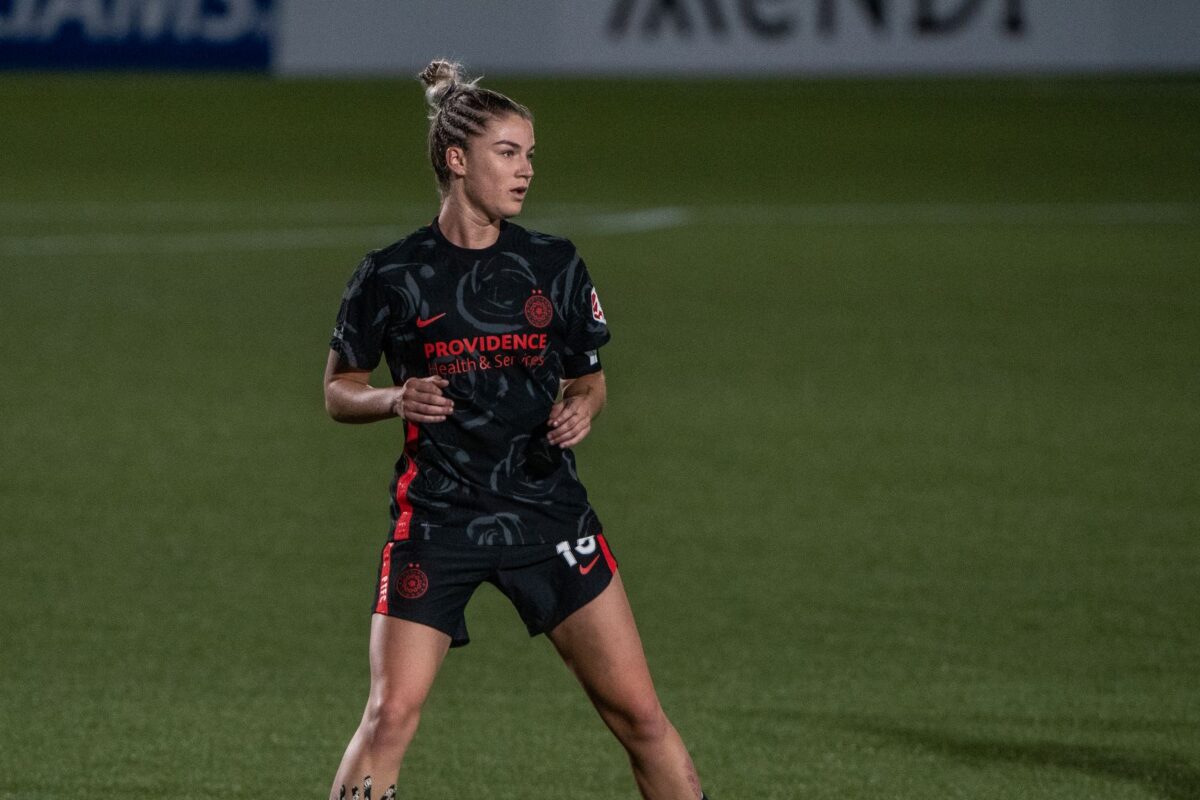
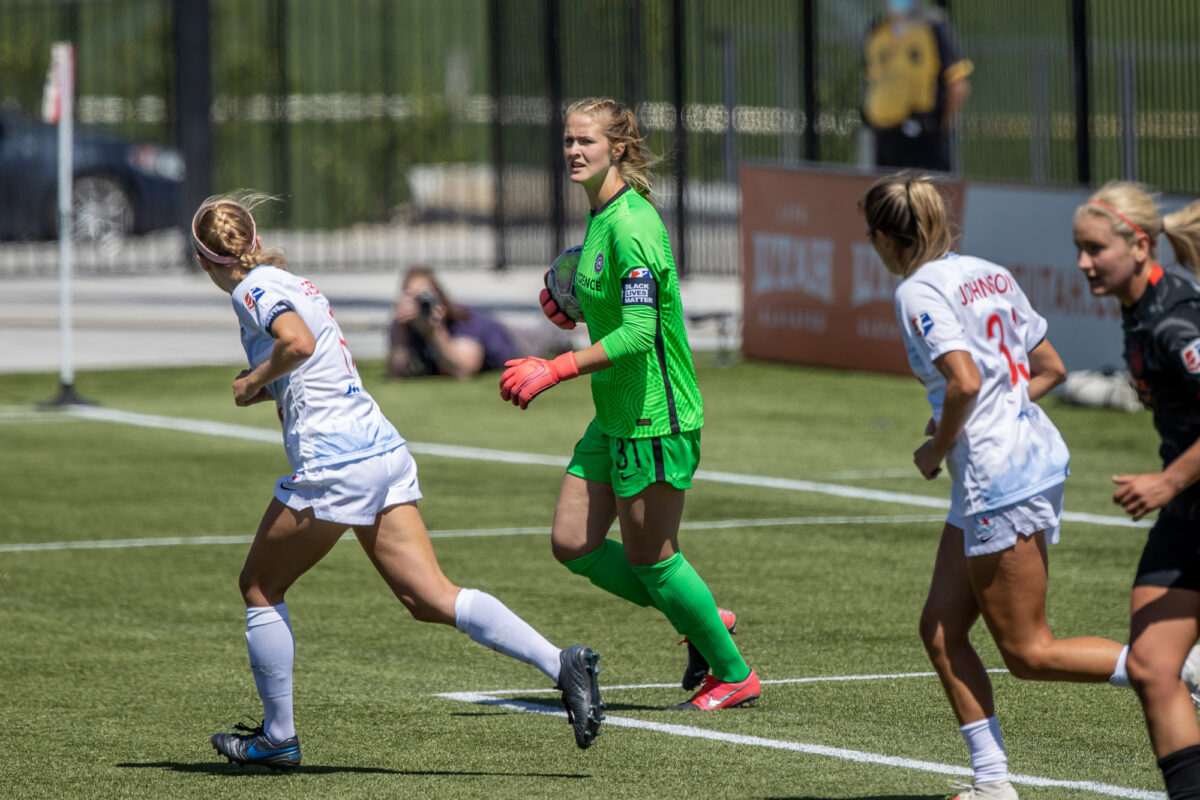
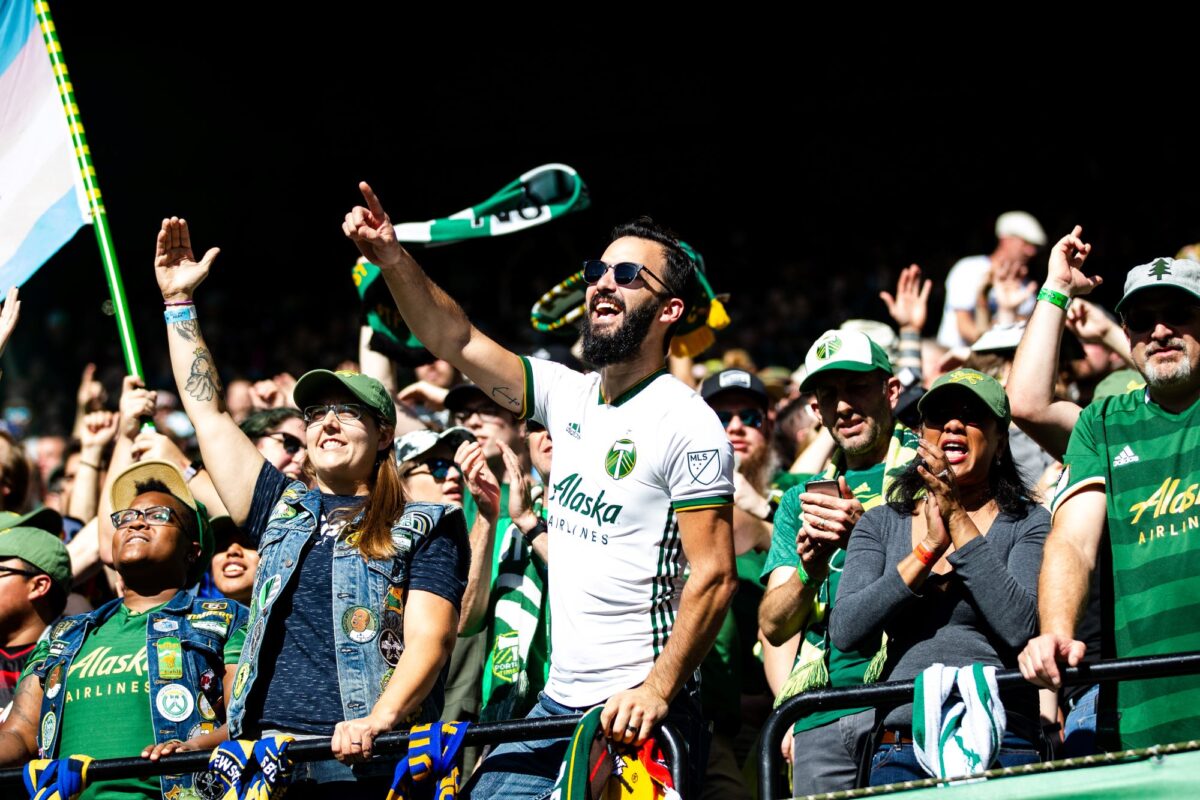
Disclosure: Jennifer Ingraham, a 107ist board member, also serves as a copy editor for Rose City Review. She was not involved in the creation of this piece in any way.
On June 1, Milo Reed published a post on Medium, detailing his experiences as a Black capo in the Timbers Army and member of the 107 Independent Supporters Trust—the nonprofit organization that coordinates both the TA and the Rose City Riveters.
Reed describes an instance from 2018, in which the 107IST Board of Directors deleted a blog post that they, a group of non-Black people, deemed to be offensive to the Black community. However, Reed, “felt that the post was not problematic & urged the 107ist board to consult communities of color before speaking for them.” He also requested the Board share a copy of his email; Reed points out that, a couple of months later, a white capo was allowed to share their own thoughts about race “on the same website [Reed] was denied access to.”
According to Reed’s post, the Board asked him to explain his requests to them at their next meeting, less than 48 hours in advance. Based on the context of the invitation, Reed believed it to be “disingenuous” and “like [the meeting] was going to be an interrogation as opposed to a conversation.”
“I can’t count the number of times I have brought a plan, concern, or proposal to a 107ist board member only to be given a metaphorical pat on the head, a terse rejection or worst of all ignored,” writes Reed. “This has only intensified in the last couple of months. I have told several people they have behaved in ways that were disrespectful & patronizing since March, only to be told ‘I’m sorry you feel that way.'”
Three days after Reed published his story, the 107IST Board shared a response, acknowledging their failure to listen to BIPOC voices in the TA and RCR—although doing so without explicitly mentioning Reed or his own blog—and declaring a commitment to publicize a detailed anti-racism plan within the next 30 days.
Reed’s post came in the wake of the murder of George Floyd, in the midst of global protests against police brutality and systemic racism and calls that Black lives matter. (“If Black Lives Matter what about Black voices?” Reed asks.)
The outcry—and wave of public statements from their Black members—has pressured many organizations to examine the role of race within the spaces they inhabit.
When examining the role of racism within these spaces, it’s important to first acknowledge that we live in a society that’s systems of power and organization were created by white people who often strove to exclude people of color. Whether through the institution of slavery, segregationist policy, or simply hostile attitudes that targeted BIPOC, they conveyed that people of color were not welcome.
Although many of these laws have been repealed, these spaces cannot be separated from their racist origins. When those in charge do not attempt to reconcile with and actively combat this racist past, those same systems of inequity remain unchecked. We see them perpetuated in the racial wage gap, in the small number of people of color—especially Black and Indigenous people, especially Black and Indigenous women—that hold leadership positions in companies, in the over-policing and mass incarceration of BIPOC, and in countless other areas of everyday life. As Simone Charley points out, these “power structures [are] so ingrained in society that to question them is to question yourself.”
Like many organizations across the United States, the TA and the 107IST are a product of the society that they belong to. Regardless of self-proclaimed anti-racism and anti-fascism, members not immune to intrinsic bias; Reed’s story shows as much. And, as tends to be the case with systemic racism, his experience is not an isolated occurrence.
“When I first moved to Portland in 2016, I didn’t know a single person there,” says Chelsea Waddell, a member of the 107IST, “definitely not anyone in the soccer community.” She recalls going to the 107IST website and reading about the group. Something stuck out to her on the 107IST’s “About Us” page: “We have always said that if you want to be Timbers Army then you already are […] Since 2013, the same has been true for the Rose City Riveters.”
“I was like, wow, what a cool sentiment,” Waddell says. “You don’t have to be anyone special or do anything to be part of this organization.
“I think you’re immediately accepted when you walk into that group,” she continues. “There’s no prior judgment of who you are because of who you are. If you’re a member of the LGBTQ+ community, which I am, and a person of color and a woman—I’m really hitting the triple threat there—you can walk in and really be embraced, but I feel like only if you agree with everybody else all the way through.”
Anabel Ramirez, who was a regular presence in the North End for roughly ten years, feels similarly about her experience in the TA. “I got hooked into it,” she says. “It felt like a cult fervor when you first join in, and you want everything: you want all the scarves, you want all the patches, you know all the chants. You get really clicked into this idea that it is a collective, and then it doesn’t feel so collective in certain aspects.”
Both Ramirez and Waddell believe that this sense of collectiveness is enforced by the unspoken expectations in the TA, and, to a lesser extent, the Riveters: standing and chanting together, cheering on the team, and staying off your phone. For those involved outside of games, it’s volunteering your time and money, helping in the creation of tifos, and contributing to 107IST fundraisers for other nonprofits around Portland.
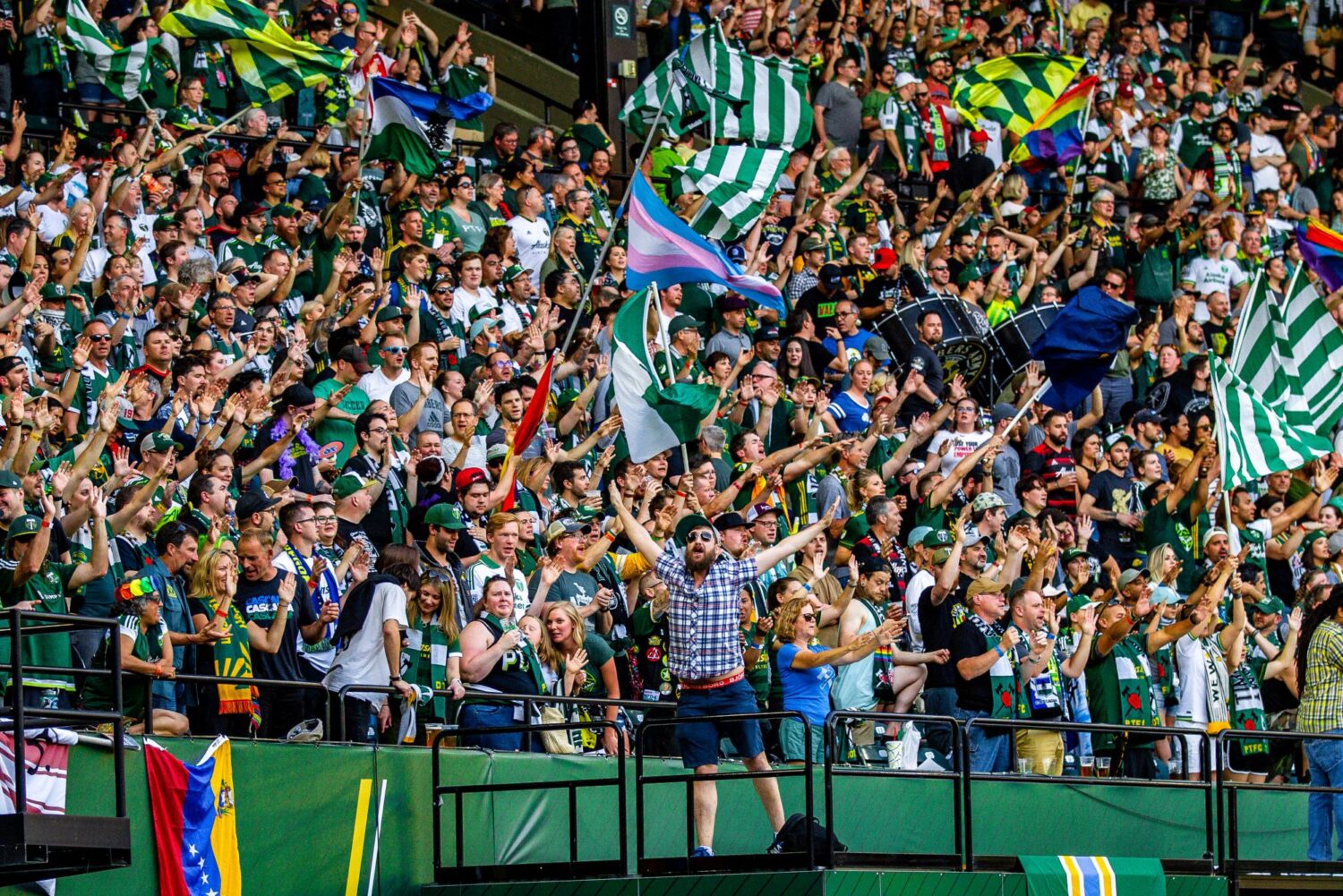
However, unspoken rules can lead those who are unaware of them, or simply wish to express their support in a different way, to feel as if they don’t belong. This is only accentuated for BIPOC fans who are already navigating a very white space.
“In trying to be this cohesive North End voice, they stamp out a lot of other voices,” Ramirez observes. “I don’t think a lot of them see themselves as stamping out specifically Black and Brown and Asian voices, but it happens.”
Ramirez points to the fact that many of her BIPOC friends don’t feel welcome in the TA—from those who simply don’t want to acknowledge the group after they displayed the Sunshine Flag, to the large numbers of Latinx families who show up at Timbers 2 matches, but not Timbers games. She, herself, felt uncomfortable in the TA unless she was with a certain group of friends.
As a Black woman, Waddell perceives the racial diversity of the TA and RCR to be similar to that of Portland, a city that is known for being very white.
To Jake Payne and Phil Bridges, this problem isn’t exclusive to Portland. The two are co-founders of Black Fires, a Black supporters group for both the Chicago Fire and the Chicago Red Stars. “You see this with a lot of supporters groups around the league,” Payne points out, “of saying that you’re inclusive and diverse, but your stands don’t really reflect that. I think that’s something that more than Section 8 or Timbers Army or anyone need to look at […] like, okay, if we’re that inclusive, why don’t our stands reflect what our values are?”
Bridges points to the fact that, in Chicago, it took over 20 years for a real push to make the stands more diverse—both in terms of LGBT and BIPOC fans—to actually happen. “You have just a lot of people who love the idea of saying that they’re diverse,” he says. “They love the idea of that, they seem open, they love talking about it, they love feeling that way, but when it comes to actually putting in the work to make sure that happens, it’s totally different.”
One of the factors is how a club markets itself. “There is the reality of soccer’s not as big as it should be in the Black community in the United States,” Payne acknowledges. On the other hand, he notes that Chicago’s clubs weren’t actively trying to engage with the Black community until Black Fires called on them to do so.
“It’s really liberating to be able to make the experience what you’ve always wanted it to be,” says Payne, “but it’s also very frustrating, because you have to constantly almost drag people to care about this in a genuine way.”
Before the COVID-19 pandemic, one of the ways Black Fires was working to reach prospective fans was through watching games with them. Payne explains that the majority of the bars that Fire supporters frequent are in the north side of the city, which is more white. “What’s a bar [where] we can watch in the south side?” he asks. “What’s a bar where we can watch that’s Black-owned or in a Black neighborhood, so that we can be more present?”
Payne thinks this engagement is an important step beyond a trap that many fall into—fans or otherwise. Too often, he points out, “donating takes the place of actually reaching out to communities that need it and making a connection.”
Both Ramirez and Waddell notice this within the TA and RCR. “I don’t feel like they are actively fighting for people of color,” Waddell says. “I think they are passively allowing them to be a part of it, and openly embracing different people, but never going any deeper than that.”
As an example, she and Ramirez point to the 107IST’s donation drives for other nonprofits in Portland.
“I do think that the organization can be a little bit show-y, white savior-y, performative,” acknowledges Waddell. “In football culture, being antifascist and fighting for marginalized people is really, really cool, but I feel like we do it just because it’s cool […] There’s just not a lot of substance there.
“It doesn’t really matter if you can fly a certain flag or wear or display a certain symbol if you’re not doing other things to support that fight. It’s just a symbol.”
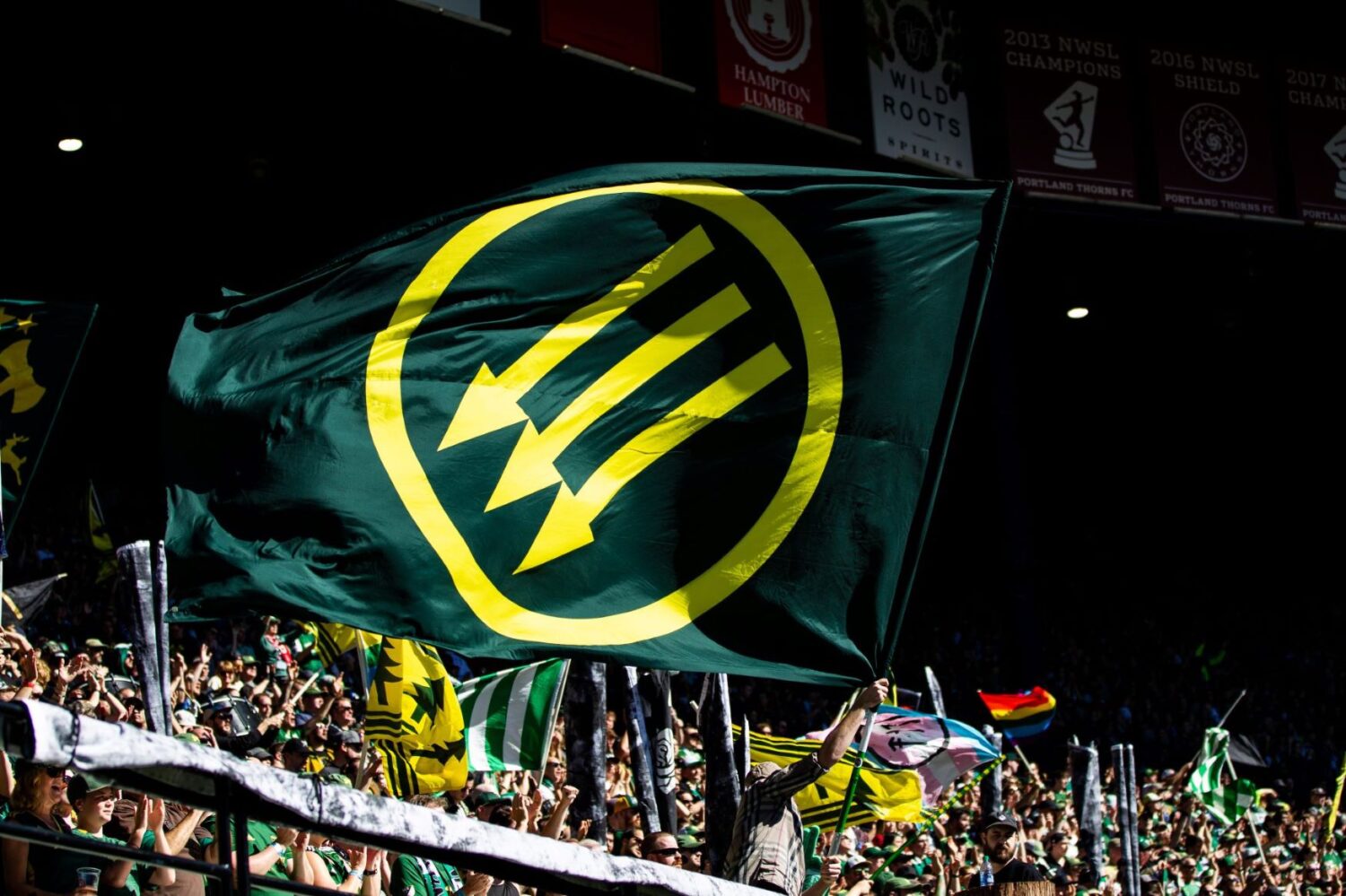
In her time with the 107IST Outreach Committee, Ramirez notes that the group would donate to organizations without making any effort to engage with the communities that those organizations represented. She explains that this was one of the main reasons she ended up leaving the committee. At the time, Ramirez said as much to the 107IST, but didn’t feel like anyone was paying attention.
“I feel like every time I would go and try to make a suggestion of some sort—it was either because I was female or because I was Latina or probably the combo—that I wasn’t getting listened to,” she says.
For Waddell, this failure to listen to BIPOC voices became evident during the discourse around the Iron Front last summer. “Obviously, this was a really passion-driven discussion, but from where I sit, part of that fight was to ‘protect’ me,” she says. “I feel like there was no space given to the people that people were fighting for.
“I just, as a person of color, didn’t see how displaying a symbol would change anything for me,” Waddell explains. “I think that’s kind of the discussion we’re at this summer, on a bigger scale, is that it’s not displaying a symbol that makes people feel safer; it’s action and words and listening to them.” While she wanted to express this at the time, she was afraid of the backlash she would face for presenting an opinion that differed from the group’s.
That fear of retaliation was validated by Reed’s post, by his stories of trying to speak up and the resistance he faced. “It was brave of him to even try,” Waddell says, “and still no one listened.”
When Reed was offered an opportunity to communicate with the 107IST Board, it was on short notice and in a space of the Board’s own creation. “[It’s] like, ‘yeah, we will listen to you,'” describes Payne, “‘but only in these predefined structures that we feel work, this is how we’ll listen to you.'”
Payne acknowledges that a refusal to listen to BIPOC voices unless they’re speaking in white-created spaces is a systemic issue: “I think that’s how a lot of places operate, not just in soccer, and it’s just not right.”
To Payne, now is a perfect time to examine the ways in which any organization perpetuates systemic racial inequity—intentionally or not. “[The] Timbers Army is just in the spotlight because they had the most public thing about it,” he says. “Plenty of other groups operate like this right now, and I think this is a good time—with it being a ‘break in society,’ with not many supporter initiatives happening—for any group, NWSL, MLS, USL, to really be thinking about, ‘okay, how are we operating?’ Especially the older groups, like Timbers Army or like Section 8: ‘this is how we’ve been operating, but is it the right way to operate?’ I think that really needs to be a big question going forward.”
“We are […] evaluating the different committees within the organization, looking to create more transparency and points of entry,” says Gabby Rosas, the newly-appointed president of the 107IST Board.
In the follow-up report from the 107IST, she shared the Board’s plan to reevaluate different areas of their operations. These include a BIPOC committee, a list of the specific places the Board is hoping to address, a summary of the outside groups the Board has formed partnerships with, and a handful of suggested books, podcasts, and movies.
“Personally, I have been reflecting on my own pathways into the organization, my own decision to run for the board, and advantages I’ve had as a white-passing person in Portland,” says Rosas, when asked about the work she’s done to examine the role of whiteness in the 107IST. “This is a large organization with many people who care passionately about the Timbers, the Thorns, supporter culture, and the community. It can be very intimidating, and I have not done a good job of recruiting and sustaining their participation, I should have been more extroverted when it comes to getting others involved in all aspects of what this organization does.”
She points to the barriers of entry that exist within the organization focusing on the time commitment asked of those involved. “There are many barriers to entry and advancement, from the supporter group involvement to the board election,” she explains. “I have been and will continue to identify barriers and address them.”
For Waddell, the hours asked of the BIPOC team was a major reason she didn’t join when invited. “I don’t really have time to volunteer to teach this Board how to just listen to people of color,” she says. “And I think there’s a lot more going on within the organization that they need to do to support people of color, but […] there’s no class you need to take or book you need to read or podcast you need to listen to to understand how to just listen to someone when they speak.”
The other factor was money. The BIPOC committee, like other 107IST committees and Board positions, is run by volunteer work. However, Waddell currently does diversity, equity, and inclusion work for her job, and felt it wasn’t worth taking on additional emotional labor—especially, for free.
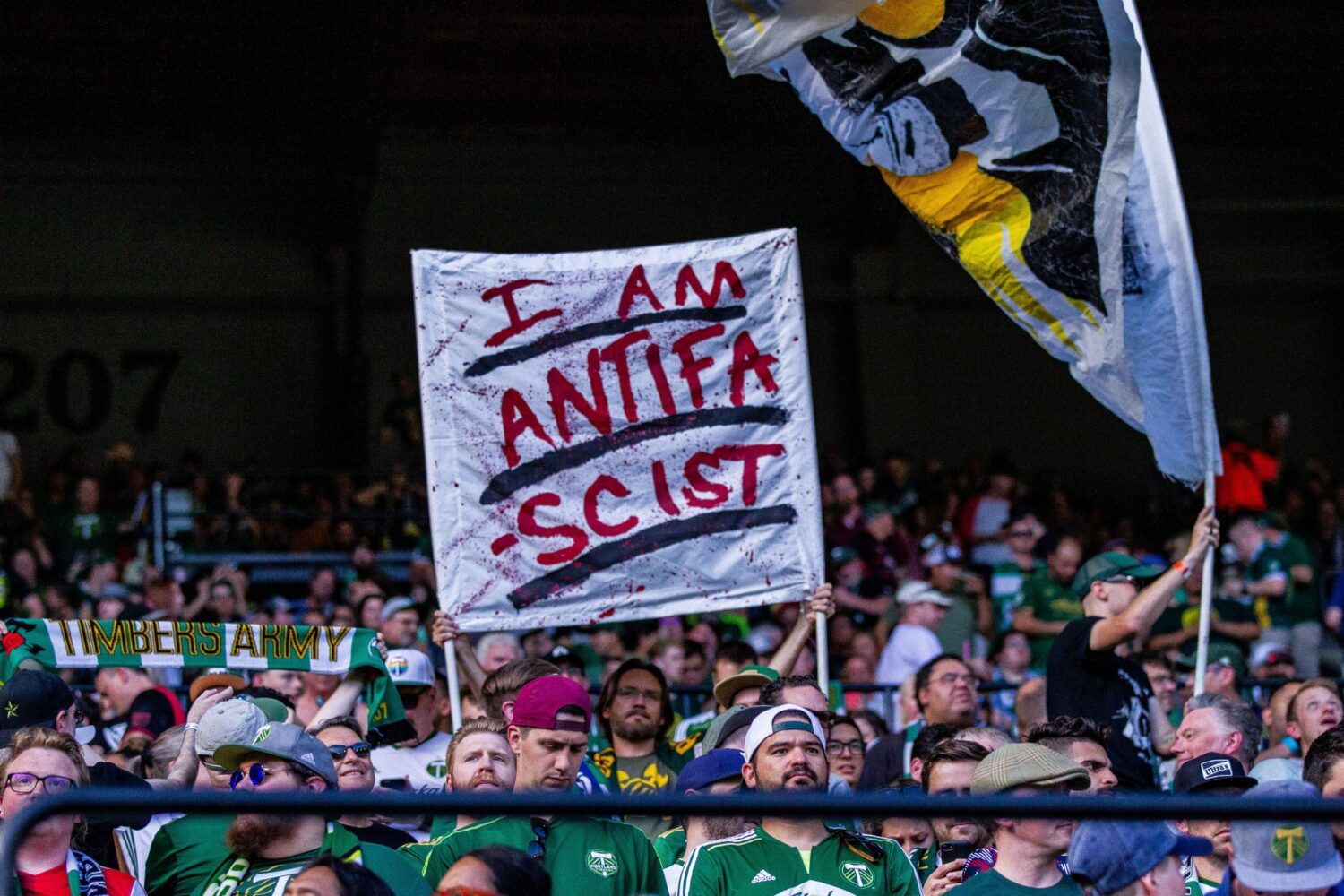
The BIPOC team shares that they now have 20 members on board, 10 of whom are currently actively involved. According to the 107IST update post, the committee has met twice so far. They “plan on meeting again soon while we work on our mission statement and other tasks that include the board.”
When asked about how the member-led BIPOC committee will remain impartial in their evaluation of the 107IST, Rosas says: “Everyone’s experience with this organization is valuable, be it positive or negative, or if they are a member or non-member. We are also not opposed to working with other local groups for guidance and insight as this committee is formed.”
The committee is not following a specified timeline, but Rosas explains that the Board isn’t planning to sit around and wait. “The hope is that as we work to remove barriers for entry and highlight different pathways in our organization, we can do so in such a way that will address the needs of marginalized groups,” she says. “As we work on change, we will be doing so at a pace where we can check in with our community, including the BIPOC team, and local organizations that have offered their support. Our goal is to be able to incorporate the feedback and tasks from the BIPOC team as they want to provide it.”
One of the ways Rosas hopes to do this is by increasing the accessibility of Board meetings. “We have never had the attendance at another board meeting like we did the June meeting,” she shares, a meeting that happened virtually to accommodate for the COVID-19 pandemic. In response, the 107IST is moving their monthly meetings to online, accessible spaces. Rosas points specifically to Google Meet, which offers closed-captioning.
As another area of focus, she hopes to more actively work with local organizations that serve BIPOC communities and other marginalized groups. “If we can increase our engagement, both through volunteering and by inviting them to 107ist events, we will hopefully be able to improve the accessibility to joining the Rose City Riveters, Timbers Army, and 107ist,” she says.
To open up space for BIPOC voices, former 107IST Board member Ray Terrill stepped down from his position and asked that his spot to be filled by a person of color. Sherrilynn “Sheba” Rawson also resigned her presidency to Rosas, although Rawson remains on the Board.
For Ramirez, those changes aren’t good enough. “Until there are at least three seats on the board filled by BIPOC, I don’t think they can move forward on this,” she says.
Rosas believes that we’ll see that shift later in the year. She explains that, as advised by Western States Center’s Eric Ward, many members have chosen “to not resign but to work on the changes until BIPOC appointments can be made or elected.”
Come Board elections in November and December, Rosas thinks the leadership changes will materialize. “I imagine that a number of board members will either choose to not re-run or step down at that time,” she says. “We will actively work with the BIPOC team should individuals want to join the board. We not only want BIPOC members on the board but also on all of the committees throughout the organization.”
Key to this will be accountability; the 107IST will have to prove that they’re seeking out and paying attention to BIPOC voices going forward. “I think a major way to prove the 107ist board is actually listening is to make changes based on what is heard and then to keep checking in to see if the changes have had an impact,” says Rosas. “I expect that many aspects of the change that is needed will not be one and done.”
Whether or not those changes play out in meaningful ways remains to be seen. However, BIPOC fans speaking up now hope that, this time, listening to their stories is a first step.
“I really love this organization,” says Waddell. “I love the team, every single player, everybody who’s at the games, everybody who’s watching from home. It means a lot to me, and that’s why I do want to speak about it. It’s not out of hate, it’s out of we can do better, and we need to do better, and we have the passion to be better […] I really do love this organization and these groups, and everything I’m saying is out of the understanding that we can be better. We have to.”
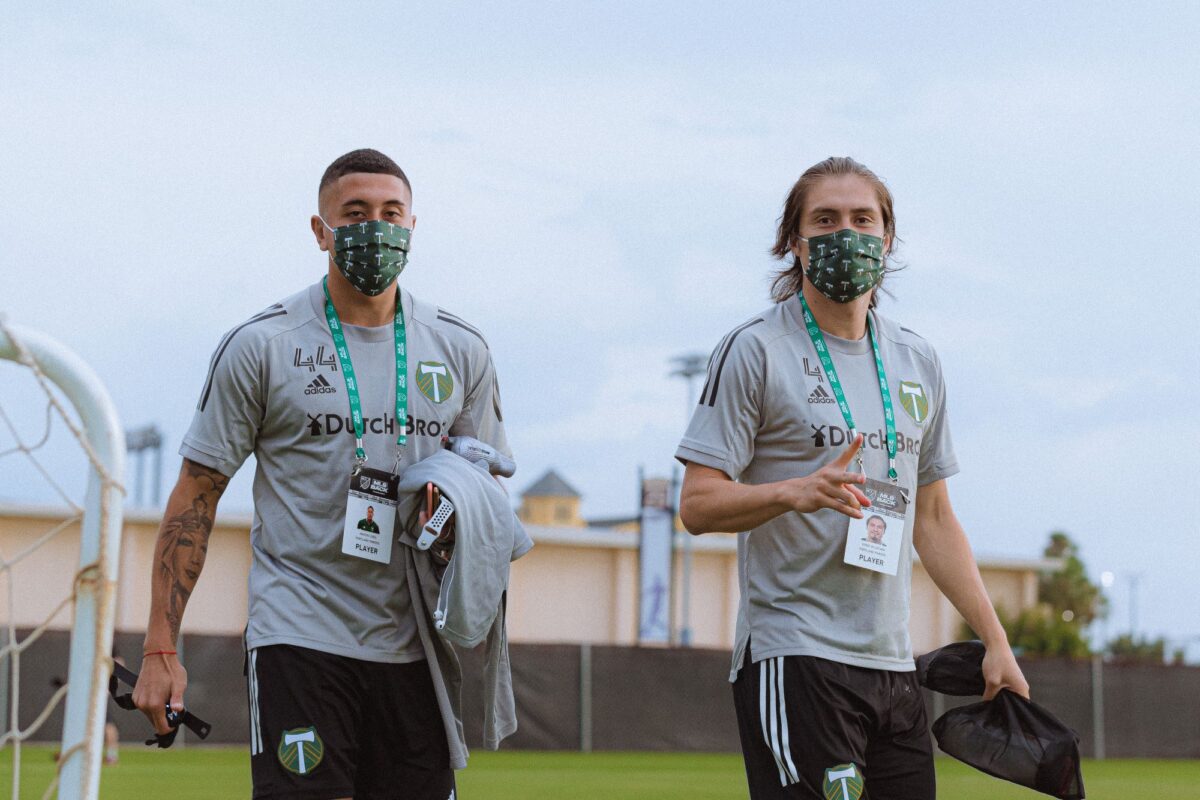
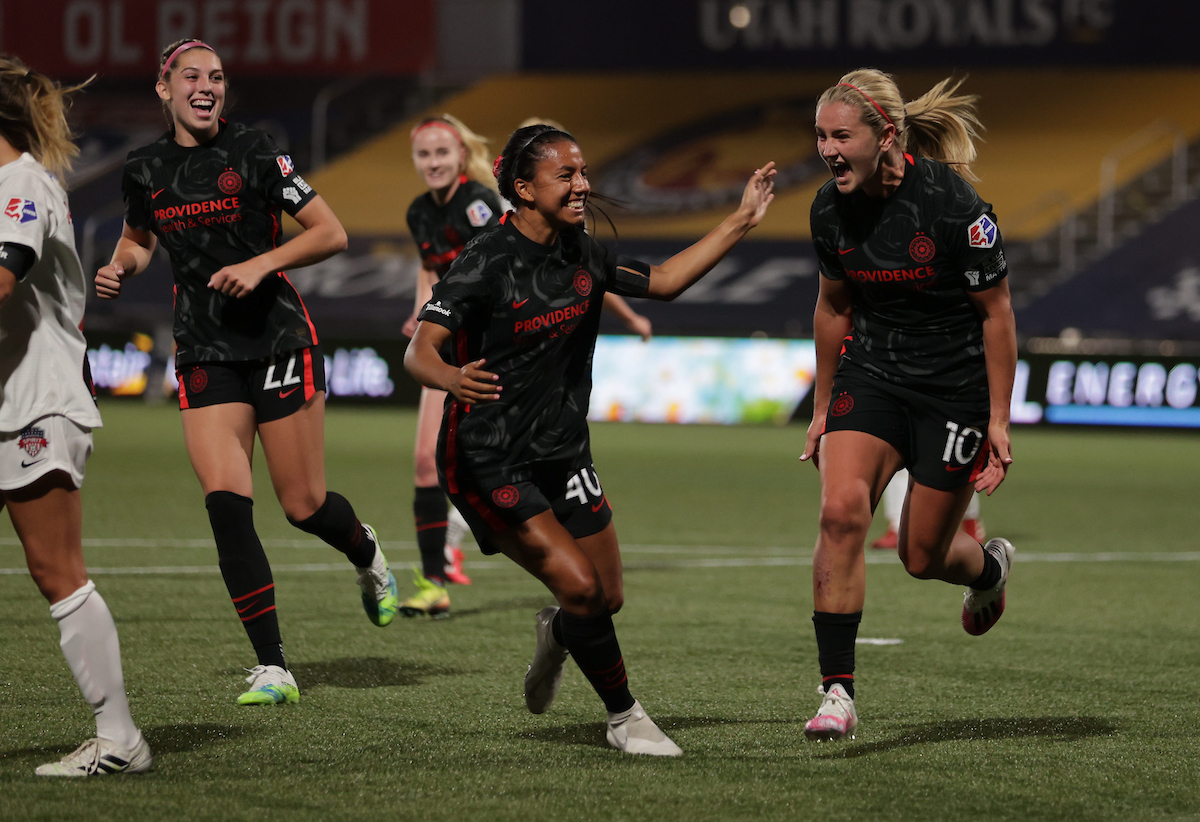
The Thorns settled for a 1–1 draw tonight against the Washington Spirit, with Lindsey Horan scoring a diving header off a free kick in the 69th minute, and conceding one, also on a set piece, a few minutes later. Let’s dig into what happened:
With each game in this tournament, we’ve seen a slightly different facet of the Thorns’ shiny new diamond midfield. Against North Carolina, we saw the team’s dual No. 8s, Lindsey Horan and Rocky Rodríguez, put wide defensive pressure on the opposing outside backs and No. 10s. On the offensive side, the duo succeeded in breaking the Courage’s press in the center of the field. In this game, we saw Horan and Rodríguez both spend a lot of time attacking in wide areas, with the bulk of Portland’s chances coming on crosses, especially in the first half.
A diamond midfield is often thought of as quite narrow, but not the way the Thorns are playing. Portland attempted an almost Courage-like 19 crosses, and players all up and down the field—from Meghan Klingenberg and Christen Westphal in the back, to Rodríguez and Horan, to Morgan Weaver up top—contributed in that area. Unfortunately, nobody managed to put any of those in the net—though a few came close.
The attack was less focused down the wings in the second half, with Horan finding a few penetrating passes toward Tyler Lussi. According to Mark Parsons, though, that wasn’t by design. “I think the desperateness to score meant that we were gravitating centrally,” he said after the game. “Width is key, and we’re going to get width from multiple areas. You can see from our forwards and also our midfield, and also fullbacks when the shape allows, and the buildup allows the fullbacks to push on. So it wasn’t a switch, unfortunately.”
The question here—and for once, despite my perennial (and fact-based) insistence that the Thorns don’t actually struggle to score goals, I think it’s a fair one—is who’s going to get on the end of those crosses. Horan, obviously, is an extremely dangerous header of the ball. Other than her, of the current healthy players, Lussi seems best suited to that role, but she seems to still be finding her way into this tournament. On the other hand, Portland did find 10 shots from inside the box, even if only four of them were on frame.
Before the tournament started, I asked whether Horan (tonight’s Budweiser Woman of the Match) is such a dominant player that she ends up posing a problem when it comes to squad-building. At the time, I was assuming the Thorns would be using a three-woman midfield as they generally have the past few years; Rodríguez’s strong showing, along with the backing of a true No. 6 in Angela Salem, have proven that specific concern wrong.
However, I still think there’s a potential issue here. Horan is so good, in so many areas of the field, that Portland would be foolish not to let her do as much as possible. She’s been ridiculous in this tournament, the most impactful single player in any of the games she’s played. She disrupts, sets play in motion, and then moves all the way up the field with it, often ending up taking the eventual shot (or, in this game, cross). In tonight’s match, she produced the majority of the chances, took the most touches, conceded the most fouls, and scored Portland’s lone goal.
It’s been a surprise to me to see both her and Christine Sinclair—with whom there’s a similar issue, if not quite to the same extent—starting every game and playing the majority of the available minutes. Parsons says she’s in the best shape of her life and can handle this week; the Thorns also now have a full, luxurious week of no games. Sinclair, meanwhile, is famously fastidious in her recovery protocol. Regardless, I still wonder why these two players started every game, especially given the amount of squad rotation the team has otherwise undergone from day to day.
I don’t have anything particularly smart to say here, but it reminds me of this: I used to play on a rec-league softball team with a friend who was a ludicrously gifted athlete. He nominally played shortstop, but because our roster tended to be split 50-50 between what I’ll call “real athletes” and “the others,” he inevitably ended up covering half the infield. He’d catch a fly ball, tag a runner, and then sprint 40 feet to ever-so-gently toss the ball underhanded to one of the lesser mortals on the team. On top of that, his movements were graceful and beautiful to watch. When he played, we could win. When he didn’t? Things… were harder.
I don’t think winning is the Thorns’ priority in this tournament, at least not at this stage; I think getting everybody minutes and figuring out how the team functions is the point. What I wonder is whether Horan is so central to the team, because she does so much, that playing without her would be a pointless exercise. I also wonder if, in the long term, relying that much on a single talismanic player might make things harder.
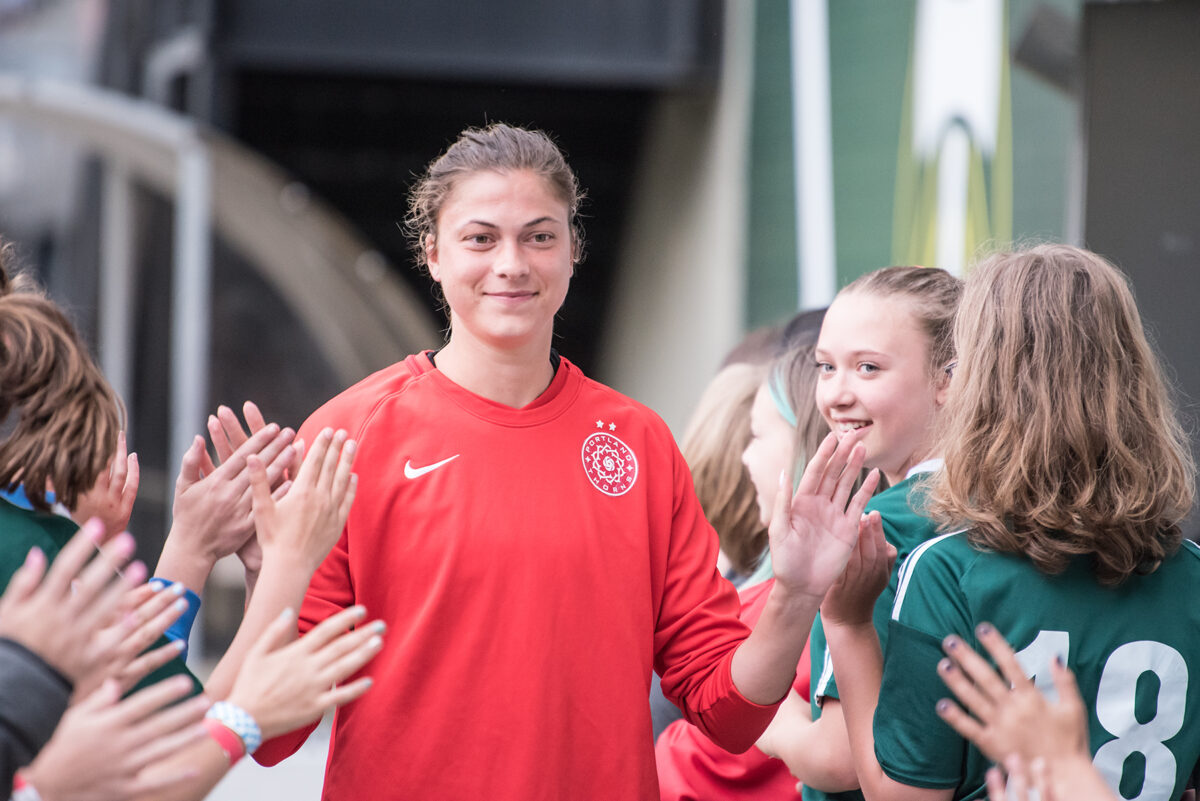
In the 23rd minute of Portland’s tournament-opening loss to North Carolina, something amazing happened. It started with Steph Labbé sending an arcing pass to Debinha in the midfield. As Debinha tried to settle the bouncing ball onto the turf, Kelli Hubly—the second sidekick in the sadly defunct Midge Purce-led dance team, she of the rolled-up shorts—charged in, got her body between the ball and her opponent, and, under pressure, completed a flailing left-footed pass to Lindsey Horan.
I have watched this sequence about eight times, both in the interest of describing it accurately above, and because I love it. I find the whole thing deeply relatable.
I’ve written a lot of words about people like Horan and Christine Sinclair and Tobin Heath over the last few years, because I like watching them play. When I get the chance, I also enjoy talking to them and hearing their coaches and teammates talk about them. But Horan and Sinclair and Heath are not the same as me.
At the same time as them being different and better than me is a major reason I like watching them, sometimes it starts to feel ridiculous writing about these people and their feats. They are basically beyond my comprehension. Their brains have a fundamentally different kind of connection to their bodies than mine does, and their bodies are also quite a bit stronger and better. There’s an inherent absurdity to me not just criticizing, but making any observations at all, about someone like Lindsey Horan. It’s like congratulating a cheetah for being fast.
Hubly, though—we are at least recognizably the same species. She’s not a hyper-competitive monster like everyone at the highest level of the sport. She’s clearly talented, to have gotten this far, but she’s talented in the way regular human beings are. She made the team, and has stayed on it, by dint of honest hard work. You get the feeling watching her that she is always trying very hard.
I have this image seared into my head which I’m not even sure is real—I’ve asked our photographers and none of them remember having captured it—of Hubly having just messed something up, either given away a goal or conceded a penalty. I believe it’s 2018, because I think she’s wearing that godawful white kit with the tire tracks on it, but I might just be remembering the Thorns kit I most associate with disappointment. She may or may not be sitting on the ground. She looks absolutely shellshocked, eyes wide, jaw tense, and I’m projecting here, but to me this is the face of someone not just deeply embarrassed about what’s just happened, but also in mortal fear of the potential longer-term personal consequences.
Thinking about that image, I can feel what that’s like viscerally in my body. I don’t think many of us can really empathize with what it’s like to do something like win a World Cup. I imagine I’d feel very happy! But I can’t picture it. Feeling like you’ve just let everyone around you down and that you might also lose your job because of it, though? That I can understand.
Another thing I can understand is the much smaller-scale victory Hubly had on Saturday. She wasn’t perfect. Lynn Williams, being Lynn Williams, burned her a few times. She let some crosses in. But she had also very clearly heard and understood her instructions for the game. She judiciously applied pressure in the areas it was needed, didn’t bite when Crystal Dunn or Jaelene Daniels tried to dribble around her, sensibly cleared the ball a number of times.
In part, as Mark Parsons pointed out in a Zoom call a few days ago, she was finally playing a role she’s actually suited to, rather than being tossed in as the third center back behind Meghan Klingenberg. This is not the story of a breakout moment, about how Hubly is good enough to replace Ellie Carpenter, about how she’s going to start for the Thorns going forward. She’s always going to be a serviceable NWSL player. But you know what? That’s fucking hard. Playing multiple seasons as the fifth or sixth defender on the depth chart and still showing up to work every day with a smile on your face, ready to keep doing your best—that takes a level of tenacity I’m not sure I can relate to. We don’t appreciate what that takes enough.
When those smaller-scale victories come, for Hubly or any of the other mortals in this league, celebrate them. We’re all out here doing the best we can.
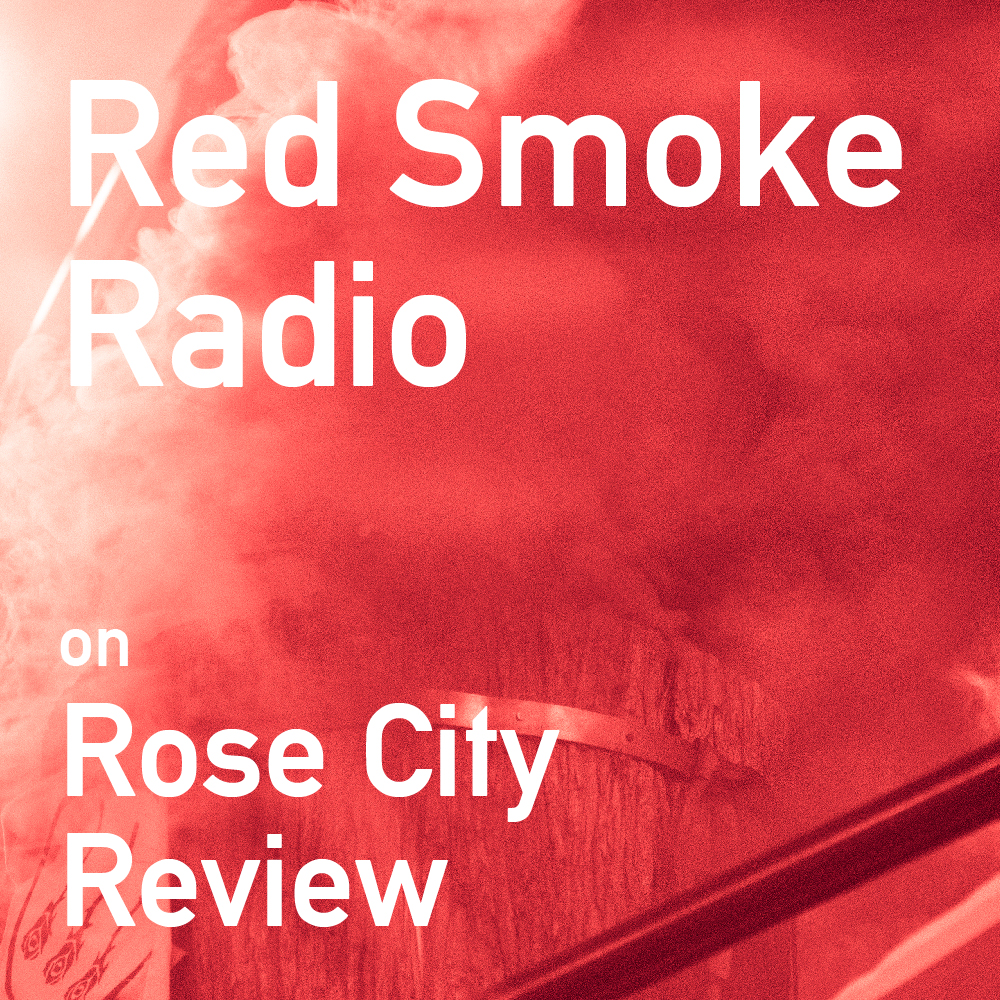
Katelyn and Tyler review the first two Thorns games of the NWSL Challenge Cup, discuss the suburban Utah masterpiece that forms its setting (including the playground), talk the Thorns diamond and their excitement about the young players on display.